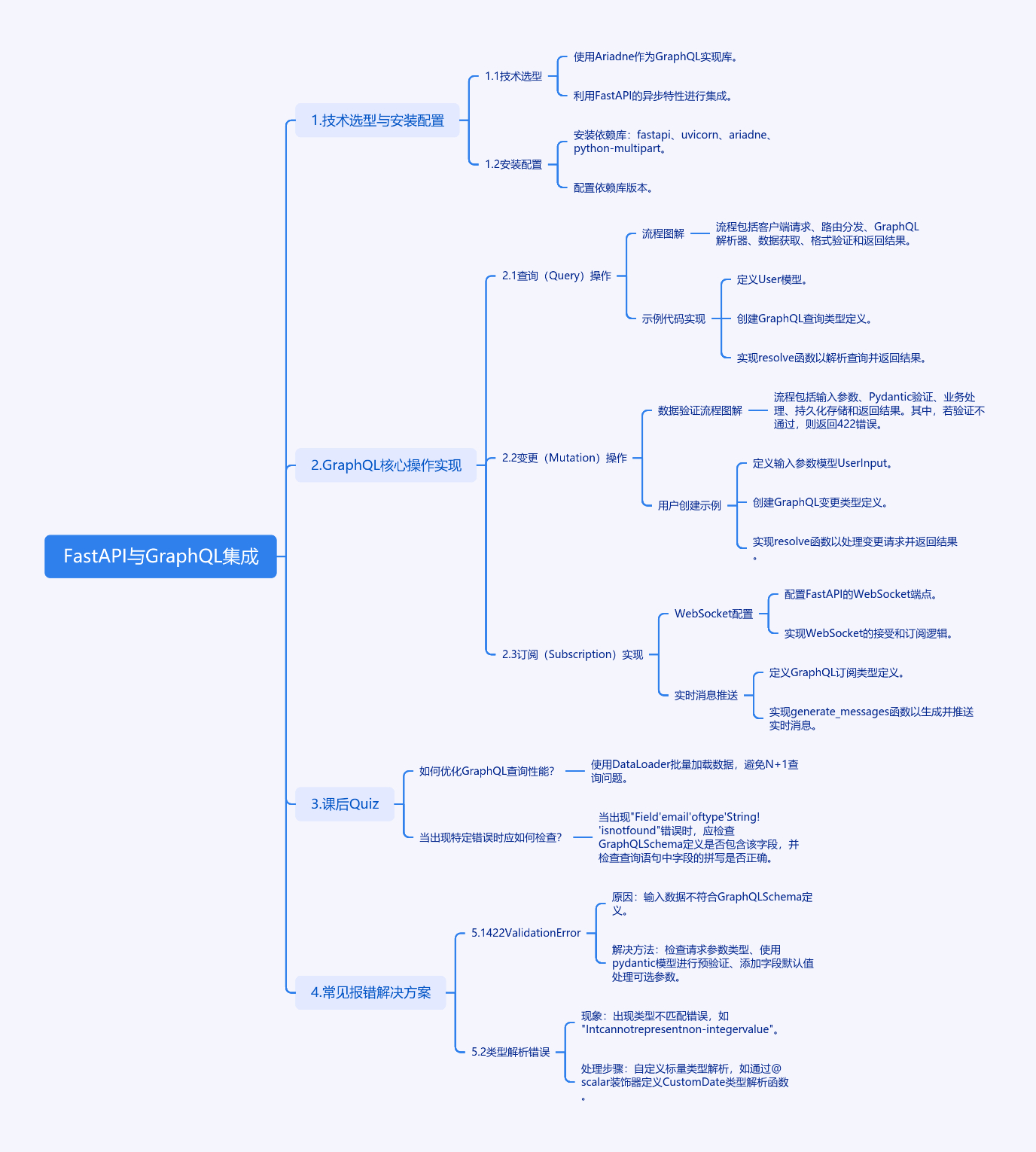

扫描二维码
关注或者微信搜一搜:编程智域 前端至全栈交流与成长
发现1000+提升效率与开发的AI工具和实用程序:https://tools.cmdragon.cn/
1. FastAPI与GraphQL集成基础
1.1 技术选型与安装配置
使用Ariadne作为GraphQL实现库,配合FastAPI的异步特性:
bash
# 安装依赖库
pip install fastapi==0.95.2 uvicorn==0.21.1
pip install ariadne==0.19.1 python-multipart==0.0.61.2 项目结构设计
推荐采用分层架构:
project/
├── main.py
├── schemas/
│ └── graphql/
│ ├── query.py
│ ├── mutation.py
│ └── subscription.py
└── models/
└── pydantic_models.py2. GraphQL核心操作实现
2.1 查询(Query)操作
流程图解:
graph TD A[客户端请求] --> B{路由分发} B --> C[GraphQL解析器] C --> D[数据获取] D --> E[格式验证] E --> F[返回结果]
示例代码实现:
python
from ariadne import QueryType, gql, make_executable_schema
from pydantic import BaseModel
class User(BaseModel):
id: int
name: str
email: str
query = QueryType()
@query.field("getUser")
async def resolve_get_user(_, info, user_id: int):
# 实际应替换为数据库查询
return User(id=user_id, name="John", email="john@example.com")
type_defs = gql("""
type Query {
getUser(userId: Int!): User
}
type User {
id: Int!
name: String!
email: String!
}
""")
schema = make_executable_schema(type_defs, query)2.2 变更(Mutation)操作
数据验证流程:
graph LR A[输入参数] --> B{Pydantic验证} B -->|通过| C[业务处理] B -->|拒绝| D[返回422错误] C --> E[持久化存储] E --> F[返回结果]
用户创建示例:
python
from ariadne import MutationType
mutation = MutationType()
class UserInput(BaseModel):
name: str
email: str
@mutation.field("createUser")
async def resolve_create_user(_, info, input: dict):
user_data = UserInput(**input).dict()
# 插入数据库逻辑
return {"id": 1, **user_data}
type_defs += gql("""
input UserInput {
name: String!
email: String!
}
type Mutation {
createUser(input: UserInput!): User
}
""")3. 订阅(Subscription)实现
3.1 WebSocket配置
python
from fastapi import WebSocket
from ariadne.types import ExtensionSync
class SubscriptionExtension(ExtensionSync):
def resolve(self, event, _):
return event.get("result")
@app.websocket("/subscriptions")
async def websocket_endpoint(websocket: WebSocket):
await websocket.accept()
# 实现订阅逻辑3.2 实时消息推送
python
from ariadne import SubscriptionType
subscription = SubscriptionType()
@subscription.source("newMessage")
async def generate_messages(obj, info):
while True:
await asyncio.sleep(5)
yield {"content": f"Message {time.time()}"}
type_defs += gql("""
type Subscription {
newMessage: String!
}
""")4. 课后Quiz
-
如何优化GraphQL查询性能?
- 答案:使用DataLoader批量加载数据,避免N+1查询问题
-
当出现"Field 'email' of type 'String!' is not found"错误时,应检查什么?
- 答案:验证Schema定义是否包含该字段,检查查询语句字段拼写
5. 常见报错解决方案
5.1 422 Validation Error
- 原因:输入数据不符合GraphQL Schema定义
- 解决方法:
- 检查请求参数类型
- 使用pydantic模型进行预验证
- 添加字段默认值处理可选参数
5.2 类型解析错误
-
现象:出现"Int cannot represent non-integer value"错误
-
处理步骤:
python@scalar("CustomDate") def parse_date_value(value): try: return datetime.fromisoformat(value) except ValueError: raise GraphQLError("Invalid date format")
余下文章内容请点击跳转至 个人博客页面 或者 扫码关注或者微信搜一搜:编程智域 前端至全栈交流与成长
,阅读完整的文章:FastAPI与GraphQL的完美邂逅:如何打造高效API?
往期文章归档:
- GraphQL类型系统如何让FastAPI开发更高效? - cmdragon's Blog
- REST和GraphQL究竟谁才是API设计的终极赢家? - cmdragon's Blog
- IoT设备的OTA升级是如何通过MQTT协议实现无缝对接的? - cmdragon's Blog
- 如何在FastAPI中玩转STOMP协议升级,让你的消息传递更高效? - cmdragon's Blog
- 如何用WebSocket打造毫秒级实时协作系统? - cmdragon's Blog
- 如何用WebSocket打造毫秒级实时协作系统? - cmdragon's Blog
- 如何让你的WebSocket连接既安全又高效?
- 如何让多客户端会话管理不再成为你的技术噩梦? - cmdragon's Blog
- 如何在FastAPI中玩转WebSocket消息处理?
- 如何在FastAPI中玩转WebSocket,让实时通信不再烦恼? - cmdragon's Blog
- WebSocket与HTTP协议究竟有何不同?FastAPI如何让长连接变得如此简单? - cmdragon's Blog
- FastAPI如何玩转安全防护,让黑客望而却步?
- 如何用三层防护体系打造坚不可摧的 API 安全堡垒? - cmdragon's Blog
- FastAPI安全加固:密钥轮换、限流策略与安全头部如何实现三重防护? - cmdragon's Blog
- 如何在FastAPI中巧妙玩转数据脱敏,让敏感信息安全无忧? - cmdragon's Blog
- RBAC权限模型如何让API访问控制既安全又灵活? - cmdragon's Blog
- FastAPI中的敏感数据如何在不泄露的情况下翩翩起舞?
- FastAPI安全认证的终极秘籍:OAuth2与JWT如何完美融合? - cmdragon's Blog
- 如何在FastAPI中打造坚不可摧的Web安全防线? - cmdragon's Blog
- 如何用 FastAPI 和 RBAC 打造坚不可摧的安全堡垒? - cmdragon's Blog
- FastAPI权限配置:你的系统真的安全吗? - cmdragon's Blog
- FastAPI权限缓存:你的性能瓶颈是否藏在这只"看不见的手"里? | cmdragon's Blog
- FastAPI日志审计:你的权限系统是否真的安全无虞? | cmdragon's Blog
- 如何在FastAPI中打造坚不可摧的安全防线? | cmdragon's Blog
- 如何在FastAPI中实现权限隔离并让用户乖乖听话? | cmdragon's Blog
- 如何在FastAPI中玩转权限控制与测试,让代码安全又优雅? | cmdragon's Blog
- 如何在FastAPI中打造一个既安全又灵活的权限管理系统? | cmdragon's Blog
- FastAPI访问令牌的权限声明与作用域管理:你的API安全真的无懈可击吗? | cmdragon's Blog
- 如何在FastAPI中构建一个既安全又灵活的多层级权限系统? | cmdragon's Blog
- FastAPI如何用角色权限让Web应用安全又灵活? | cmdragon's Blog
- FastAPI权限验证依赖项究竟藏着什么秘密? | cmdragon's Blog
- 如何用FastAPI和Tortoise-ORM打造一个既高效又灵活的角色管理系统? | cmdragon's Blog
- JWT令牌如何在FastAPI中实现安全又高效的生成与验证? | cmdragon's Blog
- 你的密码存储方式是否在向黑客招手? | cmdragon's Blog
- 如何在FastAPI中轻松实现OAuth2认证并保护你的API? | cmdragon's Blog
- FastAPI安全机制:从OAuth2到JWT的魔法通关秘籍 | cmdragon's Blog
免费好用的热门在线工具
- CMDragon 在线工具 - 高级AI工具箱与开发者套件 | 免费好用的在线工具
- 应用商店 - 发现1000+提升效率与开发的AI工具和实用程序 | 免费好用的在线工具
- CMDragon 更新日志 - 最新更新、功能与改进 | 免费好用的在线工具
- 支持我们 - 成为赞助者 | 免费好用的在线工具
- AI文本生成图像 - 应用商店 | 免费好用的在线工具
- 临时邮箱 - 应用商店 | 免费好用的在线工具
- 二维码解析器 - 应用商店 | 免费好用的在线工具
- 文本转思维导图 - 应用商店 | 免费好用的在线工具
- 正则表达式可视化工具 - 应用商店 | 免费好用的在线工具
- 文件隐写工具 - 应用商店 | 免费好用的在线工具
- IPTV 频道探索器 - 应用商店 | 免费好用的在线工具
- 快传 - 应用商店 | 免费好用的在线工具
- 随机抽奖工具 - 应用商店 | 免费好用的在线工具
- 动漫场景查找器 - 应用商店 | 免费好用的在线工具
- 时间工具箱 - 应用商店 | 免费好用的在线工具
- 网速测试 - 应用商店 | 免费好用的在线工具
- AI 智能抠图工具 - 应用商店 | 免费好用的在线工具
- 背景替换工具 - 应用商店 | 免费好用的在线工具
- 艺术二维码生成器 - 应用商店 | 免费好用的在线工具
- Open Graph 元标签生成器 - 应用商店 | 免费好用的在线工具
- 图像对比工具 - 应用商店 | 免费好用的在线工具
- 图片压缩专业版 - 应用商店 | 免费好用的在线工具
- 密码生成器 - 应用商店 | 免费好用的在线工具
- SVG优化器 - 应用商店 | 免费好用的在线工具
- 调色板生成器 - 应用商店 | 免费好用的在线工具
- 在线节拍器 - 应用商店 | 免费好用的在线工具
- IP归属地查询 - 应用商店 | 免费好用的在线工具
- CSS网格布局生成器 - 应用商店 | 免费好用的在线工具
- 邮箱验证工具 - 应用商店 | 免费好用的在线工具
- 书法练习字帖 - 应用商店 | 免费好用的在线工具
- 金融计算器套件 - 应用商店 | 免费好用的在线工具
- 中国亲戚关系计算器 - 应用商店 | 免费好用的在线工具
- Protocol Buffer 工具箱 - 应用商店 | 免费好用的在线工具
- IP归属地查询 - 应用商店 | 免费好用的在线工具
- 图片无损放大 - 应用商店 | 免费好用的在线工具
- 文本比较工具 - 应用商店 | 免费好用的在线工具
- IP批量查询工具 - 应用商店 | 免费好用的在线工具
- 域名查询工具 - 应用商店 | 免费好用的在线工具
- DNS工具箱 - 应用商店 | 免费好用的在线工具
- 网站图标生成器 - 应用商店 | 免费好用的在线工具
- XML Sitemap